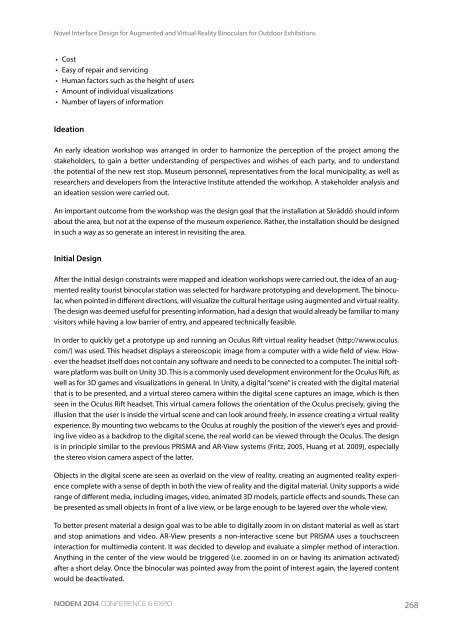NODEM 2014 Proceedings
NODEM 2014 Proceedings
NODEM 2014 Proceedings
You also want an ePaper? Increase the reach of your titles
YUMPU automatically turns print PDFs into web optimized ePapers that Google loves.
Novel Interface Design for Augmented and Virtual Reality Binoculars for Outdoor Exhibitions<br />
• Cost<br />
• Easy of repair and servicing<br />
• Human factors such as the height of users<br />
• Amount of individual visualizations<br />
• Number of layers of information<br />
Ideation<br />
An early ideation workshop was arranged in order to harmonize the perception of the project among the<br />
stakeholders, to gain a better understanding of perspectives and wishes of each party, and to understand<br />
the potential of the new rest stop. Museum personnel, representatives from the local municipality, as well as<br />
researchers and developers from the Interactive Institute attended the workshop. A stakeholder analysis and<br />
an ideation session were carried out.<br />
An important outcome from the workshop was the design goal that the installation at Skräddö should inform<br />
about the area, but not at the expense of the museum experience. Rather, the installation should be designed<br />
in such a way as so generate an interest in revisiting the area.<br />
Initial Design<br />
After the initial design constraints were mapped and ideation workshops were carried out, the idea of an augmented<br />
reality tourist binocular station was selected for hardware prototyping and development. The binocular,<br />
when pointed in different directions, will visualize the cultural heritage using augmented and virtual reality.<br />
The design was deemed useful for presenting information, had a design that would already be familiar to many<br />
visitors while having a low barrier of entry, and appeared technically feasible.<br />
In order to quickly get a prototype up and running an Oculus Rift virtual reality headset (http://www.oculus.<br />
com/) was used. This headset displays a stereoscopic image from a computer with a wide field of view. However<br />
the headset itself does not contain any software and needs to be connected to a computer. The initial software<br />
platform was built on Unity 3D. This is a commonly used development environment for the Oculus Rift, as<br />
well as for 3D games and visualizations in general. In Unity, a digital “scene” is created with the digital material<br />
that is to be presented, and a virtual stereo camera within the digital scene captures an image, which is then<br />
seen in the Oculus Rift headset. This virtual camera follows the orientation of the Oculus precisely, giving the<br />
illusion that the user is inside the virtual scene and can look around freely, in essence creating a virtual reality<br />
experience. By mounting two webcams to the Oculus at roughly the position of the viewer’s eyes and providing<br />
live video as a backdrop to the digital scene, the real world can be viewed through the Oculus. The design<br />
is in principle similar to the previous PRISMA and AR-View systems (Fritz, 2005, Huang et al. 2009), especially<br />
the stereo vision camera aspect of the latter.<br />
Objects in the digital scene are seen as overlaid on the view of reality, creating an augmented reality experience<br />
complete with a sense of depth in both the view of reality and the digital material. Unity supports a wide<br />
range of different media, including images, video, animated 3D models, particle effects and sounds. These can<br />
be presented as small objects in front of a live view, or be large enough to be layered over the whole view.<br />
To better present material a design goal was to be able to digitally zoom in on distant material as well as start<br />
and stop animations and video. AR-View presents a non-interactive scene but PRISMA uses a touchscreen<br />
interaction for multimedia content. It was decided to develop and evaluate a simpler method of interaction.<br />
Anything in the center of the view would be triggered (i.e. zoomed in on or having its animation activated)<br />
after a short delay. Once the binocular was pointed away from the point of interest again, the layered content<br />
would be deactivated.<br />
<strong>NODEM</strong> <strong>2014</strong> Conference & Expo<br />
268


